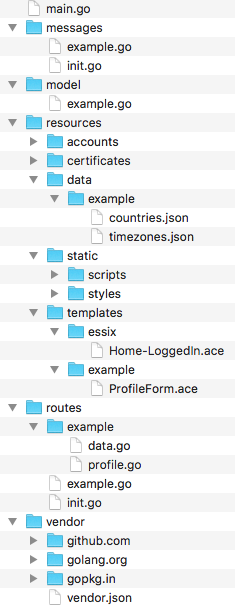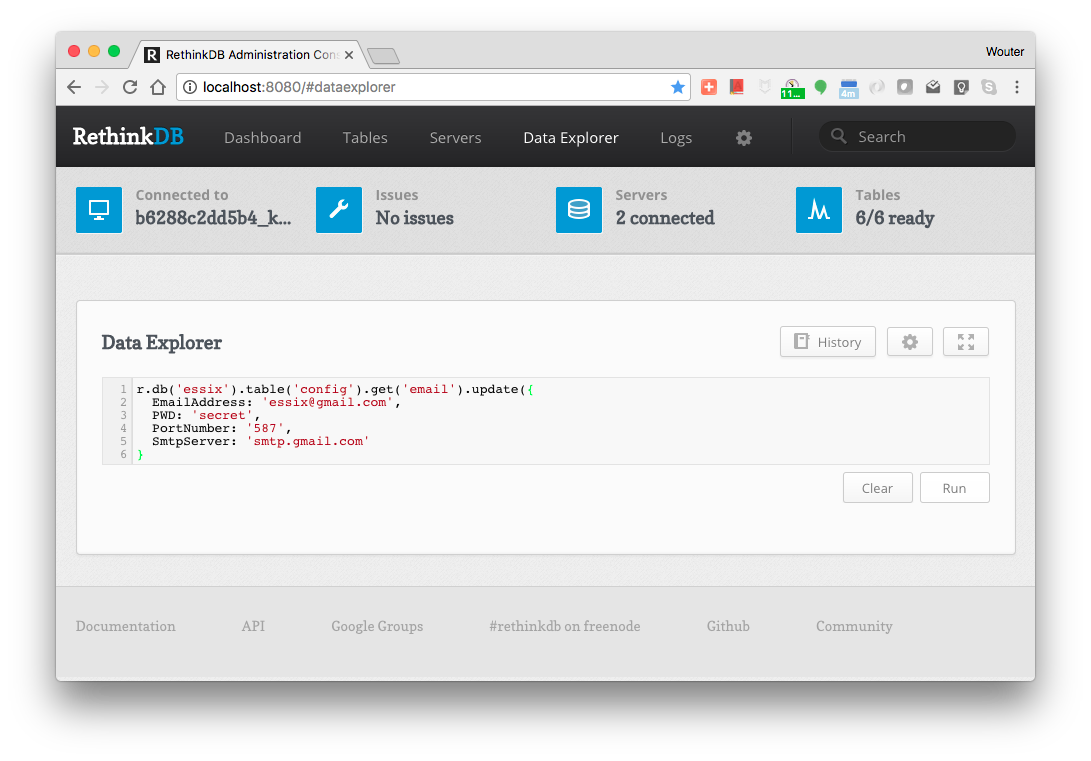Ecosyste.ms: Awesome
An open API service indexing awesome lists of open source software.
https://github.com/wscherphof/essix
Essix runs an essential simple secure stable scalable stateless server for HTTP resources.
https://github.com/wscherphof/essix
Last synced: about 1 month ago
JSON representation
Essix runs an essential simple secure stable scalable stateless server for HTTP resources.
- Host: GitHub
- URL: https://github.com/wscherphof/essix
- Owner: wscherphof
- License: lgpl-3.0
- Created: 2015-03-20T01:29:56.000Z (over 9 years ago)
- Default Branch: master
- Last Pushed: 2017-06-23T07:14:49.000Z (over 7 years ago)
- Last Synced: 2024-06-20T22:33:12.406Z (5 months ago)
- Language: Go
- Homepage: https://wscherphof.wordpress.com/2016/11/04/introducing-essix/
- Size: 1.75 MB
- Stars: 2
- Watchers: 2
- Forks: 0
- Open Issues: 0
-
Metadata Files:
- Readme: README.md
- License: LICENSE
Awesome Lists containing this project
README

Essix runs an essential simple secure stable scalable stateless server for HTTP
resources.
## Install
```
$ go get -u github.com/wscherphof/essix
```
The `essix` [command](#essix-command) manages Essix apps, their server
certificates (TLS/HTTPS), their backend databases (RethinkDB), and their
infrastructure (Docker Swarm Mode).
Follow the [Quickstart](#quickstart) to get your first app running within
minutes, on a swarm near you.
With `$ essix init`, a new Essix
[app package](#app-directory-and-profile-example) is inititialised, where you
would add your own functionality. It includes the Profile example of how things
can be done.
[](https://godoc.org/github.com/wscherphof/essix)
## Features
Essix basically provides _just what you need_ for running a reliable web
application.
### Dev
Essix cuts out the cruft, and facilitates building directly on the excellent
standards that created the web.
- The server runs [HTTP/2](https://en.wikipedia.org/wiki/HTTP/2) with
[TLS](https://en.wikipedia.org/wiki/Transport_Layer_Security) (https).
- `$ essix cert` generates self-signed _TLS certificates_, and trusted
certficates for domains you own, through [LetsEncrypt](https://letsencrypt.org/)
- Templates for [HTML](https://www.w3.org/html/) documents are defined with
[Ace](https://github.com/yosssi/ace), a Go version of
[Jade](http://jadelang.net/).
[Progressively enhance](https://en.wikipedia.org/wiki/Progressive_enhancement)
them with [CSS](https://www.w3.org/Style/CSS/) styles,
[SVG](https://www.w3.org/Graphics/SVG/) graphics, and/or
[JavaScript](https://www.w3.org/standards/webdesign/script) behaviours as you
like. Custom templates may override core templates.
- Every path in `/resources/static/...` is _statically served_ as
`https:///static/...`
- Request _routes_ are declared with their method, URL, and handler function,
e.g. `router.GET("/account/activate", account.ActivateForm)`
- Business objects gain
[CRUD](https://en.wikipedia.org/wiki/Create,_read,_update_and_delete) operations
from the [Entity](https://godoc.org/github.com/wscherphof/entity) base type,
which manages their storage in a [RethinkDB](https://www.rethinkdb.com/)
cluster.
- Server and user errors are communicated through a customisable
[error](https://godoc.org/github.com/wscherphof/essix/template#Error)
[template](https://github.com/wscherphof/essix/blob/master/resources/templates/template/Error.ace).
- The [Post/Redirect/Get](https://en.wikipedia.org/wiki/Post/Redirect/Get)
pattern is a
[first class citizen](https://godoc.org/github.com/wscherphof/essix/template#PRG).
- HTML _email_ is sent using the same [Ace](https://github.com/yosssi/ace)
[templates](https://godoc.org/github.com/wscherphof/essix/template#Email). Failed
emails are queued automatically to send later.
- Multi-language labels and text are managed through the simple definition of
[messages](https://godoc.org/github.com/wscherphof/msg) with keys and
accompanying translations. Custom messages may override core messages.
### Ops
Essix creates computing environments from scratch in a snap, scales
transparently from a local laptop to a multi-continent cloud, and only knows how
to run in fault tolerant mode.
- `$ essix nodes` creates and manages
[Docker Swarm Mode](https://docs.docker.com/engine/swarm/) swarms, either
locally or in the cloud. See the
[blogpost](https://wscherphof.wordpress.com/2016/09/13/rethink-swarm-mode/)
for the ins and outs.
- `$ essix r` installs a [RethinkDB](https://www.rethinkdb.com/) cluster on a
swarm's nodes.
- `$ essix build` compiles an Essix app's sources, and builds a
[Docker](https://www.docker.com/) image for it.
- `$ essix run` creates a service on the swarm that runs any number of
_replicas_ of the app's image.
- `$ essix jmeter` runs
[distributed load tests](http://jmeter.apache.org/usermanual/remote-test.html)
and spins up any number of remote servers to share in the generated load.
- The app server is
[stateless](http://whatisrest.com/rest_constraints/stateless_profile)
(resource data is kept in the database cluster, and user session data is kept
client-side in a cookie), meaning each replica is the same as any of the others,
every request can be handled by any of the replicas, and if one fails, the
others continue to serve.
### Security
All communication between client and server is encrypted through
[TLS](https://en.wikipedia.org/wiki/Transport_Layer_Security) (https). User
session tokens are stored as a
[secure cookie](http://www.gorillatoolkit.org/pkg/securecookie)
- HTTP PUT, POST, PATCH, and DELETE requests are protected from
[CSRF](https://www.owasp.org/index.php/Cross-Site_Request_Forgery_(CSRF))
attacks automatically, using encrypted
[form tokens](https://godoc.org/github.com/wscherphof/secure#SecureRouter).
- On sign up, the user's _email address_ is verified before the new account is
activated. User _passwords_ are never stored; on sign in, the given password is
verified through an encrypted hash value in the database. The processes for
resetting the password, changing the email address, or suspending an account,
include an _email verification_ step.
- Specific request routes can be declaratively shielded from
[unauthorised access](https://godoc.org/github.com/wscherphof/secure#Handle),
e.g. `router.PUT("/account/email", secure.Handle(account.ChangeEmail))`
- Specific request routes can be declaratively
[rate limited](https://godoc.org/github.com/wscherphof/essix/ratelimit#Handle)
(obsoleting the need for
[captchas](https://wscherphof.wordpress.com/2015/06/22/to-capthca-or-not-to-captcha/))
e.g. `router.PUT("/session", ratelimit.Handle(account.LogIn))`
- A _firewall_ is included for cloud nodes, opening only ports 80, and 443 for
the app (80 redirects to 443), 2376, 2377, 7946, and 4789 for Docker Swarm Mode,
and 22 for `ssh`. An ssh tunnel provides access to the RethinkDB admin site.
## Quickstart
1. Verify the [Prerequisites](#prerequisites).
1. Install Essix: `$ go get -u github.com/wscherphof/essix`
1. Initialise a new Essix app: `$ essix init github.com/you/yourapp`
1. Create a self-signed
[TLS](https://en.wikipedia.org/wiki/Transport_Layer_Security) certificate:
`$ cd $GOPATH/src/github.com/you/yourapp`, then: `$ essix cert dev.appsite.com`
1. Create a local one-node Docker swarm: `$ essix nodes -H dev.appsite.com -m 1
create dev`
1. Install RethinkDB on the swarm: `$ essix r create dev`
1. Run your app on the swarm: `$ cd $GOPATH/src/github.com/you/yourapp`, then:
`$ essix -e DOMAIN=dev.appsite.com build you 0.1 dev`
1. Point your browser to https://dev.appsite.com/. It'll complain about not
trusting your self-signed certificate, but you can instruct it to accept it
anyway. `$ essix cert` can generate officially
[trusted certificates](#trusted-certificates) as well.
1. [Configure](#email-configuration) the server's email account details.
1. Put your app (`$GOPATH/src/github.com/you/yourapp`) under
[version control](https://guides.github.com/introduction/getting-your-project-on-github)
& get creative.
Run `$ essix help` for some more elaborate [usage examples](#essix-command).
## Prerequisites
1. Essix apps are built in the [Go language](https://golang.org/doc/install).
1. Do create a Go working directory & set the `$GOPATH`
[environment variable](https://golang.org/doc/install#testing) to point to it.
1. The `go get` command relies on a version control system, e.g.
[GitHub](https://github.com/).
1. The `essix` command runs on `bash`, which should be present on Mac or Linux.
For Windows, [Git Bash](https://git-for-windows.github.io/) should work.
1. Deploying apps with the `essix` command, relies on
[Docker](https://www.docker.com/products/docker). Docker Machine & VirtualBox
are normally included in the Docker installation.
Essix data is stored in a [RethinkDB](https://www.rethinkdb.com/) cluster, which
the `essix` command completely manages within Docker, so not a prerequisite.
After installing Essix with `$ go get -u github.com/wscherphof/essix`, the
`essix` command relies on the `$GOPATH/src/github.com/wscherphof/essix` directory;
leave it untouched.
## Essix command
```
Usage:
essix init PACKAGE
Initialise a new essix app in the given new directory under $GOPATH.
essix cert DOMAIN [EMAIL]
Generate a TLS certificate for the given domain.
Certificate gets saved in ./resources/certificates
Without EMAIL,
a self-signed certificate is produced.
With EMAIL,
a trusted certificate is produced through LetsEncrypt.
The current LetsEncrypt approach relies on a DNS configuration on DigitalOcean,
and requires the DIGITALOCEAN_ACCESS_TOKEN environment variable.
essix nodes [OPTIONS] COMMAND SWARM
Create a Docker Swarm Mode swarm, and manage its nodes.
Run 'essix nodes help' for more information.
essix r [OPTIONS] [COMMAND] SWARM
Create a RethinkDB cluster on a swarm, and/or start its web admin.
Run 'essix r help' for more information.
essix [OPTIONS] build REPO TAG [SWARM]
Format & compile go sources in the current directory, and build a Docker
image named REPO/APP:TAG
APP is the current directory's name, is also the service name.
Without SWARM,
the OPTIONS are ignored, and the image is built locally,
then pushed to the repository. Default repository is Docker Hub.
With SWARM,
the image is built remotely on each of the swarm's nodes,
and the service is run there, with the given OPTIONS.
essix [OPTIONS] run REPO TAG SWARM
Run a service from an image on a swarm.
Options:
-e key=value ... environment variables
-r replicas number of replicas to run (default=1)
essix jmeter run JMX APP_SWARM LOAD_SWARM
Run Apache JMeter load tests, generating a dashboard report under
./jmeter-test.
JMX The path to the JMeter test plan definition .jmx file.
APP_SWARM The swarm running the app under test.
Its nodes' IP addresses are set as environment variables
NODE_0, NODE_1, ..., NODE_x
LOAD_SWARM The swarm that will run the test, distributing the
generated load across its remote JMeter servers.
Use `essix jmeter server start LOAD_SWARM` to create the remote servers.
Use `essix jmeter perfmon start APP_SWARM` to install the PerfMon Server Agent.
essix jmeter server ACTION SWARM
Provision the swarm's nodes with a remote JMeter "slave" server.
ACTION Either start, stop, or restart.
essix jmeter perfmon ACTION SWARM
Provision the swarm's nodes with the PerfMon Server Agent.
ACTION Either start, stop or restart.
essix help
Display this message.
Examples:
$ essix init github.com/essix/newapp
Initialises a base structure for an Essix app in $GOPATH/src/github.com/essix/newapp.
$ essix cert dev.appsite.com
Generates a self-signed TLS certificate for the given domain.
$ export DIGITALOCEAN_ACCESS_TOKEN="94dt7972b863497630s73012n10237xr1273trz92t1"
$ essix cert www.appsite.com [email protected]
Generates a trusted TLS certificate for the given domain.
$ essix nodes -m 1 -w 2 -H dev.appsite.com create dev
Creates swarm dev on VirtualBox, with one manager node, and 2 worker
nodes. Adds hostname dev.appsite.com to /etc/hosts, resolving to the
manager node's ip address.
$ export DIGITALOCEAN_ACCESS_TOKEN="94dt7972b863497630s73012n10237xr1273trz92t1"
$ essix nodes -m 1 -d digitalocean -F create www
Creates one-node swarm www on DigitalOcean, with a firewall enabled.
$ export DIGITALOCEAN_REGION="ams3"
$ essix nodes -w 1 -d digitalocean -F create www
Adds an Amsterdam based worker node to swarm www.
$ export DIGITALOCEAN_REGION="sgp1"
$ essix nodes -w 1 -d digitalocean -F create www
Adds a Singapore based worker node to swarm www.
$ essix r create dev
Creates a RethinkDB cluster on swarm dev, and opens the cluster's
administrator web page.
$ essix r dev
Opens the dev swarm RethinkDB cluster's administrator web page.
$ essix build essix 0.2
Locally builds the essix/APP:0.2 image, and pushes it to the repository.
$ essix run -e DOMAIN=www.appsite.com -r 6 essix 0.2 www
Starts 6 replicas of the service on swarm www, using image essix/APP:0.2,
which is downloaded from the repository, if not found locally.
$ essix -e DOMAIN=dev.appsite.com build essix 0.3 dev
Builds image essix/APP:0.3 on swarm dev's nodes, and runs the service
on dev, with the given DOMAIN environment variable set.
$ essix nodes -m 3 create load
$ essix jmeter server start load
Creates and provisions a swarm of remote JMeter servers.
$ essix jmeter perfmon start dev
Installs the PerfMon Server Agent on swarm dev's nodes.
$ essix jmeter run test_plan.jmx dev load
Runs a distributed load test on the load swarm, targeting the dev swarm.
```
# App directory and Profile example
The `essix init` command renders this directory structure:

### main.go
Entry point for the service to initialise and run the app.
### messages
Package defining messages and translations. Add custom messages (like
[example.go](https://github.com/wscherphof/essix/blob/master/app/messages/example.go)),
and/or copy any of the
[default files](https://github.com/wscherphof/essix/tree/master/messages) to
customise translations, or add translations for other languages (pull requests
welcome).
### model
Package defining business model data entities. The
[example](https://github.com/wscherphof/essix/blob/master/app/model/example.go)
defines a Profile entity, showing how to:
- Define the type, embedding the entity Base type
- Register the type as a data entity
- Construct an instance of the type
### resources
Directory with resource files for the app, that gets added to the service image,
after merging with the
[default resources](https://github.com/wscherphof/essix/tree/master/resources).
#### accounts
Let's Encrypt account data, resulting from `essix cert`
#### certificates
Certificate files resulting from `essix cert`
#### data
Any data files the app needs. The Profile
[example](https://github.com/wscherphof/essix/tree/master/app/resources/data/example)
includes a list of contries, and a list of time zones.
#### static
Any static files to serve. The example just relies on the
[defaults](https://github.com/wscherphof/essix/tree/master/resources/static)
merged in on `essix build`.
#### templates
The [Ace](https://github.com/yosssi/ace) templates for HTML documents.
[example](https://github.com/wscherphof/essix/tree/master/app/resources/templates/example)
contains the example Profile form template, and
[essix](https://github.com/wscherphof/essix/tree/master/app/resources/templates/essix)
contains a customised version of the
[default](https://github.com/wscherphof/essix/tree/master/resources/templates/essix)
home page content.
### routes
Package defining request routes and their handlers.
[example.go](https://github.com/wscherphof/essix/blob/master/app/routes/example.go)
defines the Profile example routes, and the
[example package](https://github.com/wscherphof/essix/blob/master/app/routes/example)
contains their handlers
([profile.go](https://github.com/wscherphof/essix/blob/master/app/routes/example/profile.go))
and the loading of country and time zone data
([data.go](https://github.com/wscherphof/essix/blob/master/app/routes/example/data.go))
### vendor
The vendor directory is the place where the
[govendor](https://github.com/kardianos/govendor) tool keeps track of the app's
package dependencies.
## Details
### Trusted certificates
For how to prepare for generating trusted certificates with `essix cert`, see
the
[blogpost](https://wscherphof.wordpress.com/2016/11/03/an-easy-recipe-for-lets-encrypt/).
### Email configuration
The [email](https://godoc.org/github.com/wscherphof/essix/email) function needs
email server & account details configured in the database. `$ essix r dev`
brings up the administrator site of the RethinkDB cluster (assuming you target
the `dev` swarm). Navigate to the Data Explorer, and paste this command:
```
r.db('essix').table('config').get('email').update({
EmailAddress: '[email protected]',
PWD: 'secret',
PortNumber: '587',
SmtpServer: 'smtp.gmail.com'
}
```

Replace the values with what's appropriate for your account, then click the
Run button. Restart the app server to read in the new config:
```
$ docker-machine ssh dev-manager-1 docker service scale myapp=0
myapp scaled to 0
$ docker-machine ssh dev-manager-1 docker service scale myapp=1
myapp scaled to 1
```
Note that should you choose to use a Gmail account, you need to turn on 'Allow
Less Secure Apps to Access Account' in the
[account settings](https://myaccount.google.com/u/1/security)